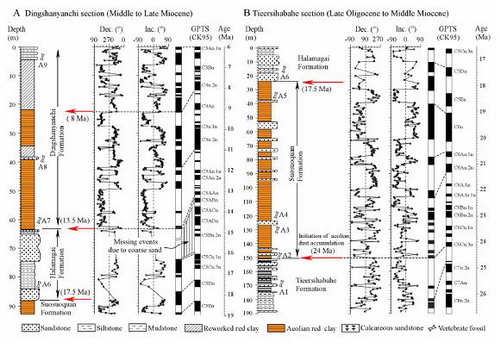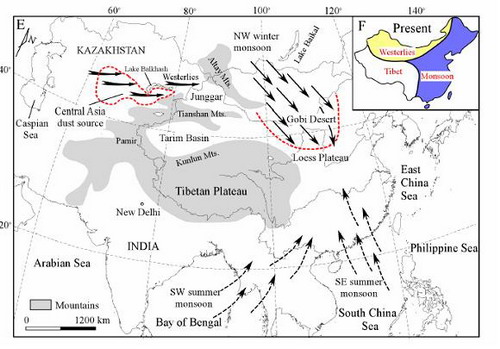China has the best terrestrial Cenozoic eolian deposits, such deposits provide important information about the provenance and wind patterns in central Asia. Compared with the tremendous studies on the Chinese Loess Plateau, the eolian deposits in the other regions are not well studied.
Recently, Prof. Jimin Sun and other colleagues report late Oligocene-Miocene aeolian red bed from the giant Junggar Basin which is about 2000 km away from the Chinese Loess Plateau. Their new results indicate that the initiation of aeolian dust accumulation in the Asian interior occurred at 24 million years ago (Fig. 1), transported by westerlies rather than winter monsoon from central Asia, implying different wind patterns are responsible for dust accumulation in different regions. This is, by now, the oldest eolian dust in central Asia. Moreover, climate similar to present has prevailed at least since the late Oligocene in central Asia (Fig. 2). This is a great contribution for studying the history of the largest mid-latitude arid zone in the Asian interior as well as its relation to the climatic effects of the uplifted Tibetan Plateau.

Fig. 1 Magnetostratigraphy of the studied sections. A: Magnetostratigraphy of the Dingshanyanchi section. B: Magnetostratigraphy of the Tieersihabahe section (declination and inclination data of this section is from Zhang et al. 2007). Red arrows indicate the boundary ages of aeolian deposition, positions of mammalian fossil assemblages (A1 to A9) are also given.

Fig. 2 E: The provenance (circled by the red dashed lines) and dust pathways of the Tertiary aeolian red clay in the Junggar Basin and on the Loess Plateau since the latest Oligocene. F: Schematic map showing the present climate pattern in China. Noting the similarity between them, demonstrating that the climate pattern similar to the present has prevailed at least since 24 Ma ago.